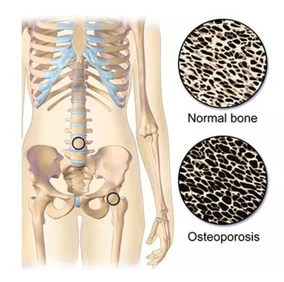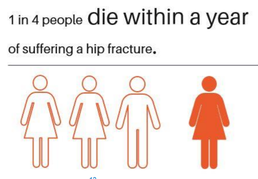Strength Training and Osteoporosis
What is Osteoporosis?
Its name comes from Latin for “porous bones.” Osteoporosis is a condition where the bones become weak and fragile. People with osteoporosis are at a high risk of fractures, or bone breaks while doing routine activities such as standing or walking. The most commonly affected bones are the ribs, hips, and the bones in the wrists and spine. The problem is, hardly anyone will know they have it until they break a bone.
Osteoporosis can occur in people of any age, but it’s more common in older adults, especially women. In the UK over 3 million people are estimated to have osteoporosis and there are estimated to be over 500,000 fractures occur in the UK each year because of it. Fragility fractures are estimated to cost the UK around £4.4 billion each year. Hip fractures alone account for 69,000 emergency admissions into English hospitals, adding up to 1.3 million bed days and a cost of £1.5 billion each year.
Its name comes from Latin for “porous bones.” Osteoporosis is a condition where the bones become weak and fragile. People with osteoporosis are at a high risk of fractures, or bone breaks while doing routine activities such as standing or walking. The most commonly affected bones are the ribs, hips, and the bones in the wrists and spine. The problem is, hardly anyone will know they have it until they break a bone.
Osteoporosis can occur in people of any age, but it’s more common in older adults, especially women. In the UK over 3 million people are estimated to have osteoporosis and there are estimated to be over 500,000 fractures occur in the UK each year because of it. Fragility fractures are estimated to cost the UK around £4.4 billion each year. Hip fractures alone account for 69,000 emergency admissions into English hospitals, adding up to 1.3 million bed days and a cost of £1.5 billion each year.
Risk Factors of Osteoporosis
While it's still fairly common in men, women are more at risk of developing osteoporosis. 1 in 3 women over 50 have osteoporosis, compared to 1 in 5 men. because the hormone changes that happen at menopause directly affect bone density.
People who consumed 1 to 2 drinks per day had 1.34 times the risk of developing osteoporosis.
People who consumed 2 drinks or more per day had 1.63 times the risk of developing osteoporosis.
While it's still fairly common in men, women are more at risk of developing osteoporosis. 1 in 3 women over 50 have osteoporosis, compared to 1 in 5 men. because the hormone changes that happen at menopause directly affect bone density.
- Heavy smoking. Smoking impacts a person at risk for developing osteoporosis in several ways. In studies, smoking has been shown to, reduce blood supply to the bones, slow the production of bone-forming cells, and Impair the absorption of calcium.
- Heavy drinking. Alcohol consumption impacts how the body absorbs calcium and vitamin D. Chronic heavy drinking can cause hormone deficiencies in men and women. Men with alcoholism may produce less testosterone, a hormone linked to the production of osteoblasts (cells that stimulate bone formation). In women, overconsumption of alcohol can decrease estrogen, which can negatively impact bone density. Six studies found published in the journal Drug and Alcohol Dependence earlier this year found a strong relationship between alcohol consumption and osteoporosis.
People who consumed 1 to 2 drinks per day had 1.34 times the risk of developing osteoporosis.
People who consumed 2 drinks or more per day had 1.63 times the risk of developing osteoporosis.
- Being underweight, or having an eating disorder, such as anorexia or bulimia greatly increases your chances of having osteoporosis.
The damage to quality of life.
Osteoporosis is a leading reason for older people breaking limbs in what would otherwise be a minor fall. An older person having a hip fracture can lead to a loss of mobility and premature death in an otherwise healthy person. It's common for an older persons health to rapidly go downhill after a fall. They fall, break a bone and while recovering, lose more strength and mobility.
Quality of life goes downhill, and they are then even more susceptible to falling again.
This is preventable and it doesn't have to happen to you.
Osteoporosis is a leading reason for older people breaking limbs in what would otherwise be a minor fall. An older person having a hip fracture can lead to a loss of mobility and premature death in an otherwise healthy person. It's common for an older persons health to rapidly go downhill after a fall. They fall, break a bone and while recovering, lose more strength and mobility.
Quality of life goes downhill, and they are then even more susceptible to falling again.
This is preventable and it doesn't have to happen to you.
Can Osteoporosis be prevented?
Yes. Simple lifestyle changes will greatly reduce your chance of getting to.
Some ways to prevent osteoporosis include:
How can I help?
Strength training is the best activity to strengthen your bones. Don't know where to start? Get in touch if you're in Nottingham and want a personal trainer who can teach you how to strength train safely and effectively.
Yes. Simple lifestyle changes will greatly reduce your chance of getting to.
Some ways to prevent osteoporosis include:
- Do weight-bearing exercise, like strength training. Weight-bearing exercise and resistance exercise are particularly important for improving bone density, and slowing the loss of bone as you age, and helping to prevent osteoporosis. This is the most important thing you can do to prevent getting it.
- Not smoking or drinking too much alcohol can leach nutrients from the body.
- Eating a healthy diet that contains enough calcium, vitamin D and protein.
How can I help?
Strength training is the best activity to strengthen your bones. Don't know where to start? Get in touch if you're in Nottingham and want a personal trainer who can teach you how to strength train safely and effectively.


